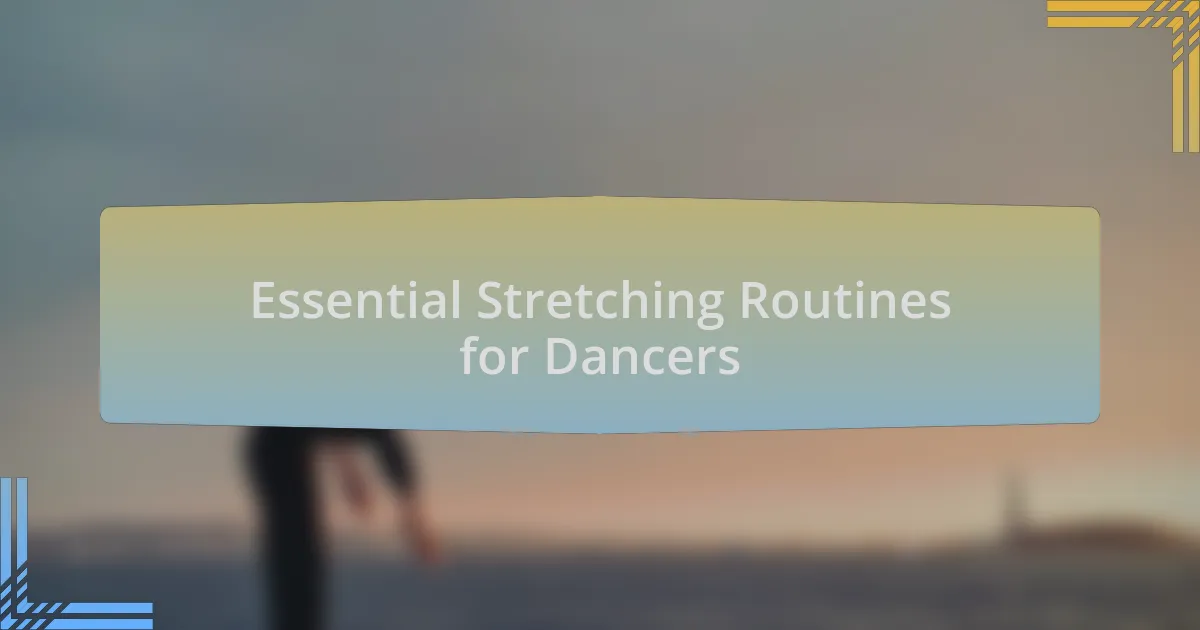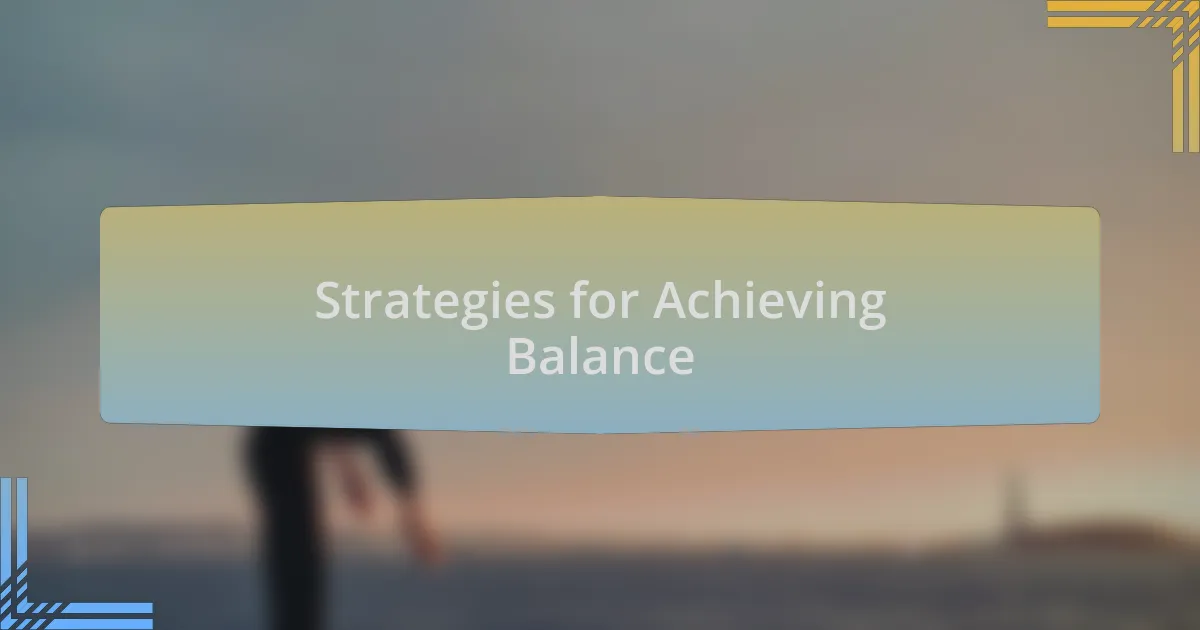Key takeaways:
- Classical Chinese Dance blends technique and emotion, emphasizing connection with music and storytelling.
- Strength and flexibility are essential for executing movements with power and grace, enhancing overall performance.
- Consistent training, including resistance exercises and yoga, fosters balance and improves strength and flexibility.
- Tracking progress and incorporating cross-training enhances motivation and leads to long-term results in dance practice.

Understanding Classical Chinese Dance
Classical Chinese Dance is not just a performance; it’s an embodiment of culture and history. I remember attending a traditional performance where the dancers seemed to weave a story, each move echoing the delicate balance of strength and grace inherent in this art form. Have you ever watched a dancer perform and felt a surge of emotion?
The dance draws inspiration from various elements of Chinese arts, including drama, music, and visual arts, creating a multidimensional experience. When I first began learning, I was struck by how every posture and gesture conveys deep meaning, reflecting the philosophies and aesthetics of ancient China. It’s fascinating to consider: how can such fluid movements hold so much weight in storytelling?
At its core, Classical Chinese Dance emphasizes both physical skills and emotional expression. My own journey in mastering this dance has taught me that it’s not just about technique; it’s also about connecting with the music and the audience. When was the last time you immersed yourself in an art form that transformed your understanding of emotion and narrative? For me, that connection is what makes this dance so powerful and enduring.

Importance of Strength and Flexibility
Strength and flexibility are the twin pillars that support the beauty and complexity of Classical Chinese Dance. I recall my early days in training when mastering the plié and stretch not only enhanced my movements but also deepened my appreciation for the artistry involved. Have you ever tried to perform a graceful high kick only to realize that your muscles weren’t quite ready? That moment of challenge highlighted how essential these physical attributes are to execute the dance with authenticity.
Flexibility, in particular, allows for the fluidity of movement, enabling dancers to transition seamlessly between poses and create that captivating visual flow. I remember vividly the first time I achieved a full split; it felt like unlocking a new level, both physically and emotionally. How does it feel to know that every stretch you take is carving out a more expressive dance style?
On the other hand, strength is what holds the dance together, allowing for powerful leaps and controlled landings that mesmerize audiences. During a recent performance, I felt the adrenaline surge through my body as I executed a difficult move, a testament to how far I’ve come. Isn’t it remarkable how strength and flexibility work together to elevate the performance, telling a story not just through movement but through the very embodiment of the dancer?

Key Techniques for Building Strength
One effective technique for building strength in Classical Chinese Dance is through resistance training. I remember integrating resistance bands into my practice; initially, it felt awkward, but gradually, I noticed my leg muscles becoming stronger during movements like the grand battement. Have you ever experienced that satisfying moment when you realize that your practice has translated into greater power and control? It’s empowering.
Incorporating core-strengthening exercises is also vital. I used to underestimate the importance of a strong core, but after focusing on exercises like planks and Pilates, I felt a shift in my performance. Suddenly, I had a newfound stability during pirouettes, allowing me to hold my balance longer. Isn’t it fascinating how one aspect of physical fitness can dramatically enhance another?
Additionally, practicing floor work can significantly build strength while connecting with the dance’s fluid nature. I specifically remember a choreography session where I spent extensive time rolling and grounding myself, which not only built my upper body strength but also offered a deeper understanding of movement dynamics. How often do we realize that exploring different surfaces and weights in our practice opens new avenues of strength?

Essential Stretching Routines for Dancers
It’s easy to overlook the critical role of stretching in a dancer’s routine, yet it’s fundamental for both flexibility and injury prevention. In my experience, dedicating time to dynamic stretches before practice has transformed my warm-up. I still vividly recall the first time I noticed how a simple leg swing added fluidity to my movements; it was like unlocking hidden potential in my dance.
One stretch that I swear by is the butterfly stretch. I remember performing it after an intense rehearsal, feeling the immediate release in my hips. Have you ever found that one stretch that just seems to melt away your tension? For me, that’s the magic of the butterfly stretch—it not only helps in opening my hips for more graceful movements but also clears my mind.
Finally, I advocate for the incorporation of static stretching after practice. After a long day of dancing, I create a calming environment and take a moment to stretch my arms overhead and gently lean to each side. This ritual not only helps with muscle recovery but also gives me a chance to reflect on the day’s progress. How often do we pause to appreciate what our bodies have accomplished through dance? Embracing these moments ensures that I remain both physically and mentally centered.

My Personal Experience with Training
When I first started my training in Classical Chinese Dance, balancing strength and flexibility felt daunting. I remember struggling to hold a balance after executing a powerful movement. It was through pushing my limits—repeating those challenging sequences—that I discovered the synergy between strength and flexibility, teaching me that each complements the other.
One memorable moment for me was during a performance when I executed a particularly demanding turn. In that split second, I felt the strength in my core holding me steady, allowing for a fluid transition into a graceful pose. Have you ever experienced the sheer thrill of combining power and grace in a single moment? It taught me that strength isn’t just about muscle but also about having the control to flow seamlessly through movements.
I’ve also found that training demands patience and consistency. There were times when my body felt sore and fatigued, and I questioned whether I was progressing at all. But every drop of sweat during those long practice sessions has resulted in not just physical growth, but emotional resilience. Isn’t it fascinating how the journey of training mirrors life itself? As I continue to evolve, I remain grateful for every challenge that shapes my artistry.

Strategies for Achieving Balance
Finding the right strategies to achieve balance in strength and flexibility has been essential for my growth as a dancer. One method that has worked wonders for me is integrating yoga into my training routine. I remember the first time I held a challenging pose; the way it stretched and awakened my muscles was an experience unlike any other. This practice not only enhanced my flexibility but also built up my strength, making movements in dance feel more accessible.
Another key strategy is setting specific goals for both aspects. During a recent training session, I decided to focus on a particular turn that required both strong legs and a flexible hip. Breaking down the movement into smaller components allowed me to concentrate on building the necessary strength while simultaneously working on my ease of motion. How often do we overlook the importance of small victories in our training? Each bit of progress has given me the confidence to push further, fostering a stronger connection between strength and flexibility through clear, achievable targets.
Finally, I’ve learned the value of active recovery days. Early in my training, I often pushed myself too hard, believing that only continuous effort led to improvement. However, embracing rest and incorporating activities like swimming or gentle stretching has transformed my recovery process. It’s incredible how giving my body time to repair can lead to greater gains in strength and flexibility. What strategies have you found helpful on your journey? Balancing these two elements often goes beyond physical practice; it requires a mindset that values rest as much as work.

Tips for Maintaining Long-Term Results
To maintain long-term results in strength and flexibility, consistency is crucial. I still remember a time when I hit a plateau; my routine had become mundane and my progress stalled. Shaking things up often reignites my passion—whether it’s trying a new dance style or experimenting with different strength exercises, keeping my training fresh keeps me motivated.
In my experience, tracking progress can be incredibly empowering. I started keeping a dance journal, noting improvements in my strength and flexibility milestones. It might seem simple, but writing down my achievements—like mastering a particularly difficult stretch—fills me with a sense of accomplishment. Have you ever considered how acknowledging your journey can fuel your commitment? Each entry serves as a reminder of how far I’ve come and pushes me to continue striving for balance.
Another tip that has worked wonders for me is integrating cross-training into my routine. Initially, I hesitated to branch out, fearing it would distract from my dance training. However, incorporating activities like Pilates has not only complemented my strength but also enhanced my flexibility. It’s fascinating how stepping outside my comfort zone can lead to surprising gains—have you explored new avenues to enhance your dance practice? Embracing various disciplines has shown me just how interconnected strength and flexibility truly are, paving the way for long-lasting results.